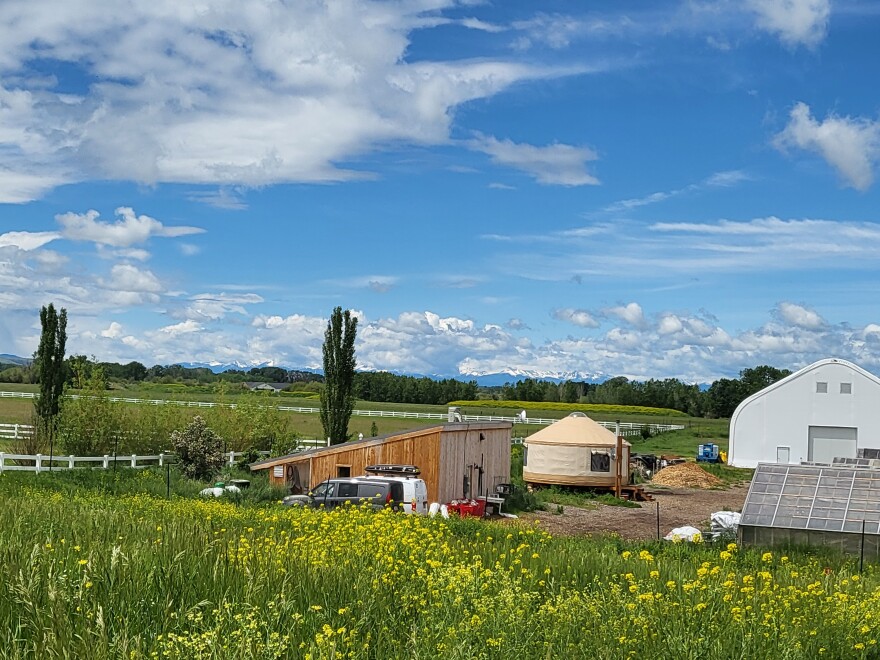Off of Love Lane, just outside Bozeman in the Three Hearts Farm, gourmet mushrooms are being cultivated by Ben Dueling at SporeAttic. Here, seven different types of Oyster mushrooms and four different Lion’s Mane along with Chestnuts and Black Pearl mushrooms grow in 940 square feet. From the five-room building about 500 pounds of mushrooms go to local restaurants, grocery stores, and the Bozeman Farmers’ Market.

“I didn’t even think I would be a mushroom farmer. I moved to Bozeman in 2017 to work on a PhD in microbiology,” Dueling says. Although he got into a good program with incredible professors and “the best labs. I had the best lab mates and I was allowed to explore all the coolest project but I was still miserable.”
Deuling says “serendipitous” events began to happen. “I started meeting all the right people at the right time,” beginning with connecting with a student he was teaching in 2019 who wanted to open a mushroom farm in Bozeman. Immediately they made plans to start a business together.
Originally his partner was to provide the monies and knowledge to create the farm along with having the skills to construct their facility. “I was going to be the scientist.” Due to “health complications, he withdrew from the business,” Dueling shares. At this point, he and his partner had looked at another property and into buying a prefabricated shed.

Deuling found himself at the Bozeman Farmers’ Market where he approached the Foxglove Flower Farm stand. “I personally don’t care about flowers. They just don’t do anything for me,” he admits, but on that day, he felt compelled to approach the booth and talk to the owners. He discovered their affiliation with Three Hearts Farm and was told there was a possibility of his setting up a business there.
This meeting led to him having coffee with co-owner Josh Hicks who would later offer to build a facility for Dueling. At the time, Dueling was considering buying an existing building and moving it to Three Hearts Farm. Hicks said he was happy to “build something custom to your design that we will be still happy to have on our property once you’re done with it.”
The result was a five-room building that consisted of an entryway leading to the porch where raw material production takes place. Here hardwood fuel pellets and soy hulls are packed into plastic bags to be later sterilized for 24 hours. The bags enter a clean room where they are inoculated with mushroom culture to be transferred to an incubation room.
“That’s just a bunch of shelving units that I scored out of JC Penny’s when they were going out of business,” Dueling shares. It’s shelving up to the ceiling with a bunch of air flow. We have three fans in there circulating so the CO2 does not build up and the heat doesn’t build up.”

After the bags colonize in two to six weeks, they move to the fruiting chamber after mycelium forms a web throughout the brick. “We’ll cut the blocks open and within two to three weeks, you’ll have your mushrooms ready to harvest.”
The mushrooms grown at SporeAttic “are considered primary decomposers meaning they break down dead wood where most of the mushrooms you get at the grocery store are secondary decomposers. Those will grow on compost and manure, and things that are already broken down.”
Four factors contribute to successful mushroom growing: temperature, lighting, fresh air intake, and humidity. Temperatures at 50 to 55 degrees F with 95% humidity make for good growing.

The result of about 500 pounds of mushrooms go to Bridger Brewing, Whistle Pig Korean, and the Yellowstone Club and many other local restaurants as well as Town and Country and the Farmers’ Market.
“We have a King Blue Oyster that is super fluffy and soft texture. We’ve got Golden Oysters that are tiny with really thin, crispy stems," Dueling says. "We’ve got Elm Oysters that are more meaty. Blue Oysters, which I’ve been told are more vegetably.” He confesses, “I personally can’t differentiate between the oysters, but a good chef could. Black Pearls are really savory, steak-like umami flavor.”
“The Lion’s Mane has been referred to as vegan seafood. A lot of people will use it in place of crab meat or lobster,” he says, and will shred the mushroom and saute it to mix up with bread crumbs, mayonnaise and eggs to make a seafood cake.
At Walkers Grill in Billings, Executive Chef Nick Steen sees mushrooms as a “super food” as mushrooms are usually readily available year-round and are versatile in preparation. In handling oyster mushrooms, Steen recommends examining for any debris and then handpicking them clean.

Because of the mushroom’s porosity, “You don’t want to introduce more water. They are a sponge. They will soak up all the water. You don’t want to lose all the special flavors,” he advised. The exception are morels which can be filled with dirt inside and out. These can be soaked to remove the grit.
Steen takes the cluster of oyster mushrooms and chars them on the grill. He then cuts them up leaving the caps whole while slicing up the stems. Into a very hot pan he adds the mushrooms, followed with the addition of avocado oil. Thinly sliced shallots followed are added and browned for several minutes. He then adds salt.
"Never season the mushrooms in the beginning," he recommends. "Season them at the end."
Crispy fried garlic, fresh chopped cilantro and chili flakes then finish the dish along with a nuoc cham — a Vietnamese sauce made with lime juice, ginger, garlic and lime juice. Butter completes the dish, with coconut milk as another thickening option. The result is a sauce flavoring the mushrooms, warranting rice or a hunk of bread for soaking up the sauce.
With SporeAttic producing gourmet mushrooms, chefs and home cooks have more fungi options than the mundane white or brown button choices.




